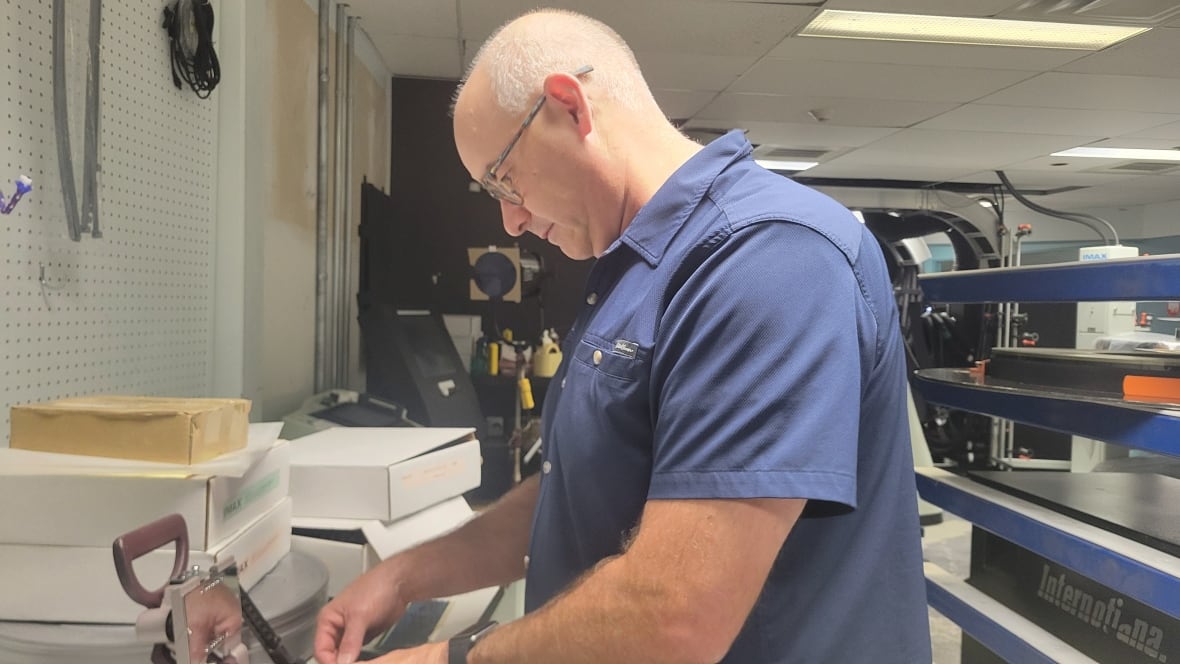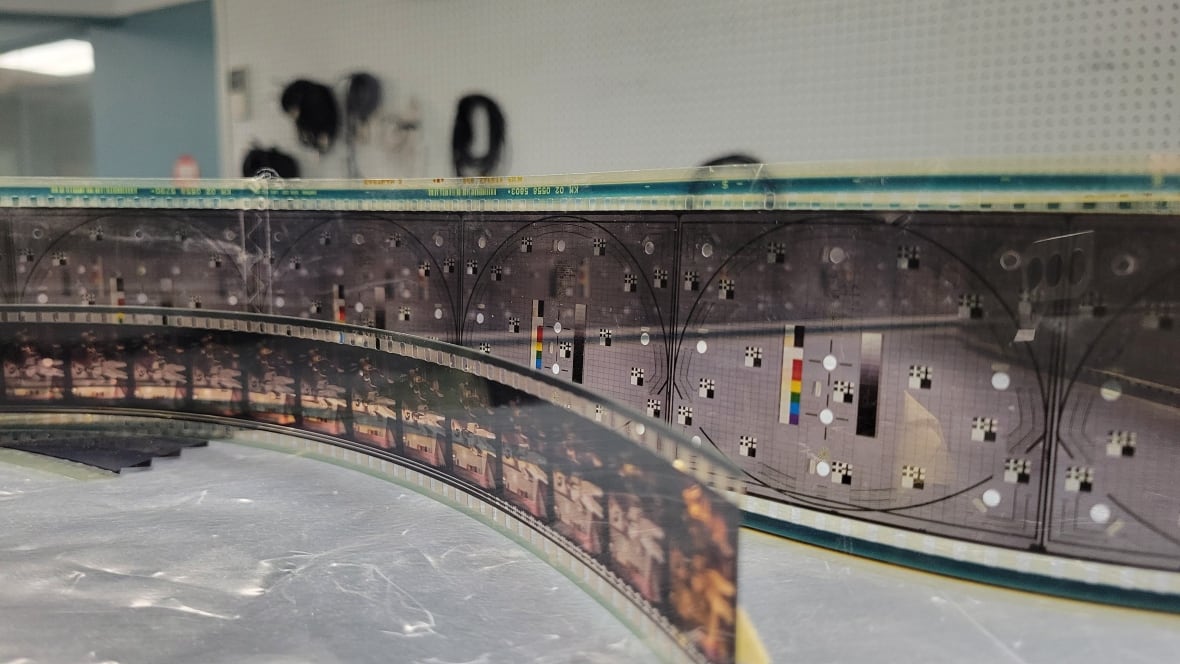Sellouts for Nolan's The Odyssey show audiences' hunger for movies projected via film
26 theatres worldwide selling tickets for 70-mm Imax screenings a year in advance

A shattered statue, scattered amber, smoke plumes, a hint of defiance, a release date and a director's name — the theatrical teaser and accompanying poster for Christopher Nolan's The Odyssey was all it took for the film to sell out select cinemas a year in advance of its July 17, 2026, release date.
The select theatres — 16 in the U.S., six in Canada, two in the U.K., one in Australia and one in the Czech Republic — are all expansive cinemas that project on 70-mm Imax film.
The rush could be interpreted as a rejection of near-ubiquitous digital screenings in favour of the analog appeal of celluloid.

The Kramer Imax in Regina's science centre is one of the theatres projecting Nolan's latest in 70-mm. The 147-seat theatre has sold out all four of its available shows for the next year, including a 2 p.m. show on Thursday. Ryan Holota, the centre's chief operating officer, said tickets started to fly as soon as they went on sale July 17.
"I think people are really starting to understand how rare of an experience it is to be able to watch a movie on film, especially in 2025."
Until 2023, Kramer Imax only used film with its Imax Small Rotor 15/70-mm projector. The theatre decided to add a digital projector — the Imax Grand Theatre Laser — because of a lack of movies releasing on film, Holota said.
He said they feel rewarded for preserving and keeping the film projector operational.
"It's really a special thing to be a part of that when we're selling movie tickets to people that live in Finland or Florida or the Middle East. We've had people fly out to watch shows here," he said.

The Odyssey is the first commercial production to be filmed entirely with Imax cameras, but not the only recent movie to put its shot-on-film status in the forefront.
Ryan Coogler's recent outing Sinners, partly shot on film, quickly garnered critical acclaim and commercial success after releasing in theatres in April. Following its release, hundreds of thousands of people watched Coogler's YouTube explainer on aspect ratios, illustrating differences between Super 8, Super 16, 35-mm and 65/70-mm films.
Holota said he's seen the inquisitiveness about movie formats increase in real time. He said moviegoers are more informed than ever.
"I certainly have seen times when we've run film, people have said, 'what would this look like in digital?' If we had a digital screening, they say, 'what would this have looked like on film?'" he said.
"I think now people, sort of, are really starting to understand the differences, and oftentimes seeking out that experience."

Mark Welton, president of Imax Global theatres worldwide, said the demand is not just on the consumer's end. Welton said he's seeing more movies shot with film cameras.
Although the company debuted four more cameras last year, which allows two Imax shoots to occur concurrently, there's still a finite number of them available — 12 currently.
"[It is] because we're seeing so much demand from the directors," he said.
The number of people filling theatre seats for the big screen experience is evident in the company's financial reports. In the first six months this year, Imax's net income almost doubled to $20.4 million, compared to $10.5 million in the same period last year.
Imax digital and Imax film
More recently, Mission: Impossible —The Final Reckoning, F1: The Movie, Fantastic Four: First Steps, Thunderbolts*, and Superman were all partly or fully shot on Imax digital cameras, which are different from the film cameras Nolan has used.
Despite the similarities in projection ratios, Welton said more people have started gravitating toward the feel of film.
"It's really the gold standard for resolution, clarity, and scale," Welton said. "It's like vinyl. Vinyl is the way that you really listen to the music world."

In 2008, the company introduced Digital Imax, a lower-cost system that used two 2K digital projectors. Since then, the company has released multiple variations of the digital systems, like the one at Kramer that uses a dual laser. The film projector, on the other hand, runs physical 70-mm film through the projector.
Regina's Kramer theatre has an aspect ratio of 1.43:1, which means the screen width is 1.43 times the height. For Imax movies, Holota says, this gives viewers about 40 per cent more image than a standard movie.
Kramer has the largest screen in Saskatchewan. Both the digital and film projector are capable of filling up that entire screen, but Holota said there are differences. He said there's an extra bit of warmth and film grain when a movie is shot and replayed on film.
"There's just sort of a fluidity to it that just makes it feel a little bit more organic, and maybe a little bit more lifelike."
Holota said there is significance in the journey celluloid makes from filmmaker to viewer and beyond.
"It's like your theatre leaves its fingerprint on every film print that you have. If we ship that print somewhere else, there's sort of like a piece of the Kramer Imax with it, which I think is really cool," he said.

Tyson Liske, a Regina resident, has bought his tickets for The Odyssey a year in advance. It's the first time in his life he's bought tickets this early, he said.
"You almost have the fingerprint of the filmmaker themselves on the film itself as you watch it. It's really true to life as best they can recreate what's happening in that scene," he said.
"You can do so much with digitization, which is great and phenomenal, but there's something really special about that permanence on the film itself, which really adds to the experience for me."
Liske said he watched Nolan's 2020 movie Tenet twice — once in Imax and once in a normal theatre.
"Those who are missing out, it's just a different experience. I think it's like comparing apples to oranges."

Siddhant Adlakha, a freelance movie critic, said he's seen 70-mm film screenings sell out for weeks and months at a time.
"It seems to have exploded in a really interesting way post-pandemic," he said.
"In an age when so much of theatrical projection is digital, I think there is a desire for that nostalgia, that old world tactility."
Accessibility of the 'intended' format
Some filmmakers, including Nolan and Coogler, have referred to Imax as the intended experience. Nolan's Oppenheimer was projected on film in 30 cinemas worldwide, with 25 of them being in North America.

Imax was founded in Mississauga in 1967 after four Canadians bought the rights to the "rolling loop" film movement system from an Australian inventor. In 1971, the first permanent Imax theatre was opened in the Cinesphere at Ontario Place in Toronto.
Despite its Canadian roots, the country only has six screens selling tickets for The Odyssey on film as of Saturday: two in Toronto and one each in Calgary, Regina, Edmonton and Vancouver.
Welton said there isn't yet a set number for how many cinemas will screen Nolan's adaptation of the Greek epic on film, but that they're aiming to increase the number by roughly 20 per cent over the next year.
Even with a 20 per cent increase over Oppenheimer, The Odyssey would only be projected on film in less than 40 theatres worldwide, but Adlakha said that number could be increased if the will is there.
"It wasn't that long ago that even the most remote parts of the world would still receive 35-mm film prints for new film releases. So it's not that crazy to think that the same thing could theoretically be done for 70-mm Imax, given the right infrastructure."
Regina's Kramer Imax employs a projectionist on contract for shows involving film projectors. It's also now training employees on operating and handling film.
Adlakha said one of the issues is decades of strides in automation that have put many projectionists out of work.
"If people are willing to invest that money and give projectionists the time and money and training, I think [expansion] is absolutely doable."


